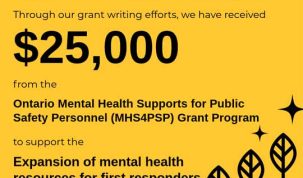By Cecilia Nasmith/Today’s Northumberland
Encouragingly lower COVID-19 numbers notwithstanding, only widespread vaccinations will truly bring progress in getting past the pandemic.
Haliburton Kawartha Pine Ridge District Health Unit Medical Officer of Health Dr. Ian Gemmill evoked a garden-hose metaphor in support of this statement. While the floods of case numbers gush out of the COVID hose, restrictions and stay-at-home orders put a thumb over the nozzle and curtail the gush. But only the vaccinations will turn off the faucet.
Dr. Gemmill cautioned against impatience in this effort, given the early stumbles on the vaccine-supply end. Nevertheless, he said in his weekly media scrum, the initial 700 doses have made a big difference at the few long-term-care homes they were deployed to – a vaccination rate of 99-100%.
The health unit has received the freezers to store the Moderna vaccine, which helps to streamline the process. Barring last-minute changes of plan, he added, another 1,000 doses are expected within days. This could potentially take care of “almost all” long-term-care residents. Then, toward the end of the month, they can start vaccinating long-term-care staff and essential care givers.
Dr. Gemmill explained that “essential care giver” is a term designated by the province at the start of the pandemic to describe a person chosen by a long-term-care resident (or perhaps by his or her family) to be the designated person to come in regularly to provide hands-on care to that person that frees up staffers in a long-term-care home to attend to other residents.
It is essential work, he noted, and should be one of those essential errands permitted even in a stay-at-home order.
An advisory committee has been struck to brainstorm on the vaccine roll-out process, and their input will be invaluable as they work toward getting vaccines into the arms of all 180,000 residents of the region.
“What I can tell you is, we are going to work out with our partners the most efficient way, the safest, the fastest way and the quickest way to get the vaccine into arms,” he declared.
Dr. Gemmill said there are nine outbreak situations among long-term-care homes – “in outbreak” being the designation the province has set for any facility where one or more resident or staffer tests positive.
If you differentiate among those nine by referring to the more minor-scale outbreaks as situations, the number truly in outbreak would be two – Caressant Care McLaughlin in Lindsay and Hope Street Terrace in Port Hope.
Dr. Gemmill cannot fault the response at these facilities in their infection-control procedures. But from his own experiences in other parts of Ontario, “one of the characteristics of these outbreaks is – despite the best efforts of all involved – they tend to drag on.”
People tend to forget it’s also flu season. But with all the infection-control measures that are part of almost everyone’s routine, the severely curtailed international travel, and shutdowns and stay-at-home orders, there have been only 55 cases across Canada as of Jan. 22.
Dr. Gemmill reiterated his strong support of stay-at-home orders, as they keep numbers down until such time as vaccinations can be undertaken on a larger scale – “which I hope is not too many weeks from now.”
Asked about the more communicable variants of the vaccine that are around, Dr. Gemmill said they have not been detected within the region – though everyone has to be concerned about that possibility.
“Some of the experts are predicting it will replace the less transmissible strain and become the predominant strain, so we have to watch for that.”
No evidence has arisen as yet to suggest the vaccines in use fail to protect against these new strains, he added.
The question of administering all available vaccine vs. holding back second doses to be sure they are on hand is controversial, Dr. Gemmill said. But there is no evidence that an extended wait for the second shot is detrimental – though administering a second shot too soon would have negative consequences.
At any rate, it should not be a factor. All indications are that, by the time a second dose is needed, the supply chain should be more reliable.
























